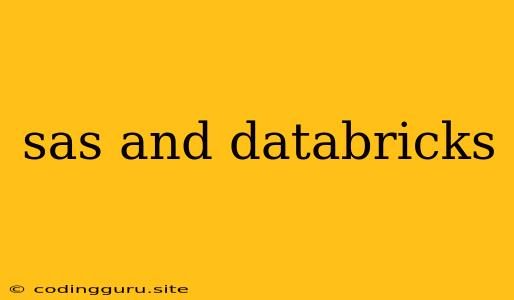Harnessing the Power of SAS and Databricks: A Comprehensive Guide
In the modern data landscape, organizations are constantly seeking ways to extract meaningful insights from vast amounts of data. Two powerful platforms, SAS and Databricks, have emerged as leaders in this domain, each offering unique capabilities to empower data scientists and analysts. While SAS has long been a stalwart in the analytics world, Databricks' rise has brought a fresh perspective with its focus on cloud-based, open-source technology.
Understanding SAS and Databricks
SAS, short for Statistical Analysis System, has been a cornerstone of data analysis since its inception in the 1970s. It boasts a comprehensive suite of tools for data management, statistical analysis, data visualization, and model deployment. SAS is known for its robust statistical capabilities, its ability to handle complex data structures, and its emphasis on data quality and integrity.
Databricks, on the other hand, is a cloud-based platform built on Apache Spark, an open-source engine designed for large-scale data processing. Databricks offers a unified environment for data engineering, data science, and machine learning, enabling organizations to perform data transformations, build machine learning models, and deploy analytical solutions quickly and efficiently.
Choosing Between SAS and Databricks: A Decision Framework
Selecting the right platform depends on your specific needs and priorities. Here's a breakdown of factors to consider:
1. Data Management and Analysis:
- SAS: Offers a rich set of tools for data management, cleansing, and transformation. Its data quality and validation features are unparalleled.
- Databricks: Exhibits strength in data ingestion, transformation, and aggregation, particularly for large-scale datasets. Its Spark engine is highly efficient for parallel processing.
2. Statistical Capabilities:
- SAS: Provides a comprehensive set of statistical procedures for data analysis, modeling, and forecasting.
- Databricks: Offers basic statistical functions but relies on integration with R and Python libraries for more advanced statistical analysis.
3. Machine Learning:
- SAS: Has a robust machine learning library with advanced algorithms for supervised and unsupervised learning.
- Databricks: Offers a flexible environment for machine learning, allowing you to use libraries like scikit-learn, TensorFlow, and PyTorch, providing a wider range of options for model development and deployment.
4. Deployment and Scalability:
- SAS: Can be deployed on-premises or in the cloud, offering a high level of security and control.
- Databricks: Is a cloud-native platform, providing scalability and flexibility, with integrations with various cloud providers.
5. Learning Curve and Support:
- SAS: Has a steeper learning curve due to its proprietary language and user interface. However, it provides extensive documentation and support resources.
- Databricks: Benefits from a more accessible learning curve, as it leverages popular programming languages like Python and Scala. Its active community offers ample support and resources.
6. Cost:
- SAS: Typically involves a higher upfront cost, with licensing fees based on usage.
- Databricks: Offers a more flexible pricing model, based on consumption and resources used.
7. Integration:
- SAS: Offers integration with other SAS products and third-party tools.
- Databricks: Provides seamless integration with cloud services and open-source tools, offering more flexibility in building data pipelines and deploying models.
Harnessing the Synergy: Combining SAS and Databricks
It's important to note that SAS and Databricks are not mutually exclusive. Organizations can leverage the strengths of both platforms to achieve their data analysis goals. Here are some ways to integrate them:
- Data Preparation in SAS: Utilize SAS for data cleaning, transformation, and validation before feeding it into Databricks for further processing.
- Statistical Modeling in SAS: Develop statistical models in SAS and export them to Databricks for deployment and real-time predictions.
- Data Visualization in SAS: Use SAS's powerful visualization capabilities to explore and present insights derived from Databricks-processed data.
Conclusion:
SAS and Databricks represent powerful platforms for data analysis, each offering unique strengths and catering to different needs. Choosing the right platform depends on your specific data requirements, organizational goals, and budget constraints. By understanding the strengths and limitations of each platform, organizations can leverage their complementary capabilities to unlock the full potential of their data.
